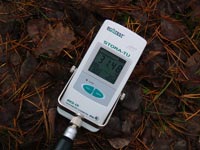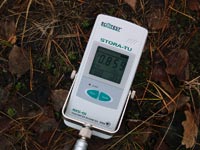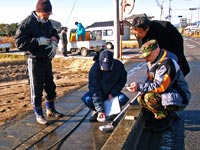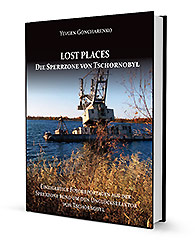Technical characteristics. Usage impressions.
With the development of dosimeter-radiometer RKS-01 “Stora-TU” became the beginning of history of SPPE “Sparing-Vist”. Later will appear “Terra”, “MKS-U”, “Cadmium”, “Poshuk” and other devices, but then, in the 90s of last century, the newly formed company, consisting of three engineers, entered the market with a single device. And it was the “Stora-TU”. Of course, this was a completely different device that does not have anything in common with the new “Stora”, except the name. But in any case, this devise became a hallmark and a mascot of “Sparing-Vist”. It is already the year 2012 and RKS-01 “Stora-TU” (of course in the new version) produced and sold worldwide.
The radiometer-dosimeter RKS-01 “Stora-TU”. The new version
In fact, this is the fourth version of the RKS-01 “Stora-TU”. In the second version (the year 2000) a discrete DMC was replaced by a microprocessor. In mid-summer 2010 was announced a third, a transitional version, in a more compact and ingress protection case, called “Stora-B”. And finally in the spring of 2011 goes into production the fourth, currently the latest version. It combines the latest developments: ingress protection enclosure of "Stora-B" with the level of protection IP54 and a new circuitry with additional features and a big multi-character screen.
No-frills package – an oblong box of plain white cardboard.
The delivery kit: dosimeter-radiometer RKS-01 “Stora-TU”, cloth bag, extension rod with bracket and mounting screws, CD with software for Windows XP, user manual and warranty card.
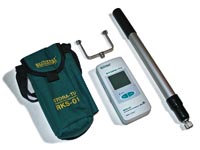 |
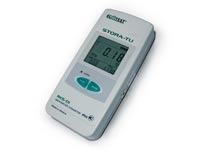 |
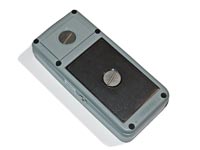 |
The first impression when I took the instrument in my hands – the heaviness, but nice heaviness. It does not irritate, but rather gives a feeling that you hold in your hands not a toy or a souvenir, but a serious professional devise. This impression is reinforced by the look of well-matched halves of a case and massive screws on lids of the battery compartment and the beta filter. Almost a pound of “live” weight – this is a payment for the accuracy and reliability of measurement. The device uses a heavy multi-layered energy compensating detectors screen. The new RKS-01 “Stora-TU” and the new “Terra MKS-05” are very similar by the interface and feature set: the screen is given at the same time information about the measured value (EDR, Beta-particles flux density), the measurement relative errors in percentage, type and units of the measured value, alarm threshold level, current time, battery status indicator, turning on of audible alarm, Bluetooth and an alarm clock.
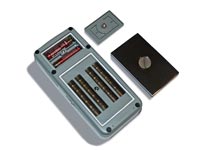 |
 |
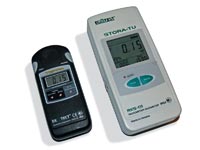 |
Moreover the big screen in the new RKS-01 “Stora-TU” appeared the non-volatile memory on 1200 cells, where it is possible to record the results of measurements, Bluetooth interface for transfer the measurement results from the device to a computer or for work as an intellectual detector (there is also a cheaper version, without Bluetooth and without the possibility of a connection to a computer). Also now it is possible to preset the measurement error. Besides all this the devise has an alarm clock, not very needed feature from my point of view, but in any case, it doesn’t disturb me.
In contrast with the new “Terra MKS-05” the screen of RKS-01 “Stora-TU” is bigger and a pseudo- analogue indicator of registered radiation intensity contains two more segments. Also, unlike the “Terra MKS-05”, the devise has not a function of counting the dose, time of dose accumulation and vibration alarm. And alarm of exceeded programmed threshold levels is audible and visual, same as in previous versions of “Stora”.
Purpose of use
- Measurement of gamma and X-ray radiation ambient dose equivalent rate.
- Measurement of surface beta-particles flux density.
- Real time measurement (clock), alarm clock.
Features and innovations
- Three independent measuring channels with alternate indication of data on the single liquid crystal display.
- New big display with luminescent backlight.
- Simultaneous indication of measurement units, measurement errors, threshold level and real time.
- Pseudo-analogue twelve segment indicator of registered radiation intensity.
- Possibility to perform measurements with a preset error.
- Prompt evaluation of gamma background within 5 seconds.
- Automatic subtraction of gamma background at measurement of beta contamination.
- Four built-in gamma, beta sensitive Geiger-Muller counters.
- Automatic setting of measurement intervals and ranges.
- Audio signalling of each detected gamma-quantum and beta-particle with the ability to disable it.
- Two-tone audio and LED alarm of exceeded programmed threshold levels.
- Four-level indication of battery discharge.
- Built-in memory which allows storing up to 1200 measurements and 999 numbers of the measured objects with possibility to view the recoded information on the personal digital display.
- Mode of PC connection via Bluetooth.
- Case with the IP54 ingress protection rating.
- Two AAA size batteries.
- Ability to work with a telescopic rod (up to 1m).
Specifications
|
||
|
µSv/h
|
0,1…999,9;
±15% |
|
1/(cm²·min)
|
5…100 000;
±20% |
|
||
|
MeV
|
0,05…3,0;
±25% |
|
MeV
|
0,5…3,0;
|
|
mSv/h
10³/cm²·min |
0,01
0,01 |
|
hours
|
1 500
|
|
kg
|
0,44
|
|
°С
|
-20…+50
|
|
mm
|
160×75×35
|
I would also like to dwell on the work of the device in the IDU mode (intelligent detection unit). I was actively using this mode in Fukushima prefecture trip in December 2011 to map the contamination. RKS-01 “Stora-TU” was connected via Bluetooth to the smartphone HTC (Windows Mobile 6). On the smartphone was installed special software “RadTrack Mobile” in conjunction with the navigation software OziExplorer. I can definitely say – it's a completely different level of work with this device. All control on devise takes the smartphone software: setting thresholds, selecting the type of radiation being measured, setting the frequency stored in memory smartphone measurement results with geo-referenced maps and the location (by time interval or distance between the measuring points).
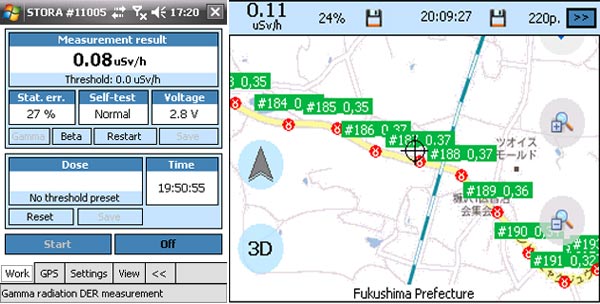
 What I like: high sensitivity and quick response to changes in the measured value, the big screen with luminescent backlight. The possibility of a permanent illuminating of the screen, possibility to preset the measurement error, non-volatile memory. High-quality, sturdy and waterproof case. Working in the IDU mode.
What I like: high sensitivity and quick response to changes in the measured value, the big screen with luminescent backlight. The possibility of a permanent illuminating of the screen, possibility to preset the measurement error, non-volatile memory. High-quality, sturdy and waterproof case. Working in the IDU mode.
 What I do not like: the impossibility of quick turn on and off the audio alarm. Bad readable pseudo-analogue scale of the intensity of measuring radiation. Not sufficiently wide range of measurement of gamma radiation and beta particles flux density.
What I do not like: the impossibility of quick turn on and off the audio alarm. Bad readable pseudo-analogue scale of the intensity of measuring radiation. Not sufficiently wide range of measurement of gamma radiation and beta particles flux density.
The summary.
I have had experience of using the old (second) version of the RKS-01 “Stora-TU” and I liked the device. It was a simple device for measuring, lean and mean. If talking about the new, fourth version of “Stora-TU”, I consider it as the most successful and balanced professional devise of the entire product line of “Sparing-Vist”. Four detectors SBM-20, although at a disadvantage in sensitivity to gamma radiation to searching scintillators and in sensitivity to the soft beta radiation to detectors with a mica window, but in any case they provide a much greater sensitivity and responsiveness than most consumer and professional devices based on a single detector SBM-20. I liked quite a practical set of the device features – only a necessary, nothing superfluous. The device is clearly not a pocket-sized – hence vibration alarm is not needed. The devise is focused on the search work – hence the function of counting the dose can be waived.
Unfortunately, some poor, by my own opinion, things the new “Stora-TU” has adopt from the new “Terra MKS-05”: enable/disable of audible alarm is on the bottom of menu, and a pseudo-analogue scale is thin and poorly legible. But these details will not affect to my positive impression of the “Stora-TU” – it's a great budget search devise.
According to my personal 10-point scale, I give the device 9 points. An excellent device.
Author: Yevgen “KRANZ” Goncharenko
| Search dosimeter-radiometer MKS-11 GN “Spectra”< Prev | Next >Gamma Radiation Warning Device aGent-R |
|---|








